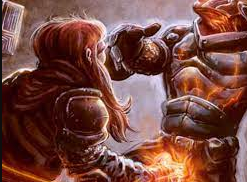You can cast a melee spell on a creature you’ll reach. The target suffers 3d10 necrotic damage upon a hit.
For every slot level above first, the damage of this spell will increase by 1d10 once you cast it using a spell slot of the second level or greater.
Inflict Wounds 5e
Casting Time: 1 action
Range: Touch
Components: V S
Duration: Instantaneous
Classes: Cleric
You do not consider the Cleric overpowered since none of his domains cause wounds at level 1. Keep in mind that a sorcerer usually takes area of effect damage at a safe distance (usually).
It’s worst case scenario for both: The cleric misses his attack and loses his spell. As a sorcerer, you cast low damage thunderwaves, which each creature saves against. However, you have more damage output. This is not to say that one is better than the other, but rather that given the right conditions either side may have a bigger advantage
In other words, inflict wounds aren’t significantly more powerful than other 1st-level attack spells. There is no doubt it does more damage than any of the others in the books, however, it is also the one that requires the greatest risk of the caster and therefore has the greatest limited targeting potential because it is melee-range and single-target.
Inflict has a similar average damage to magic missile (slightly higher, but no range) assuming a 70% chance to hit. The inflict number is misleading because it masks the real number of swingers. There are times when it won’t do any damage at all, but it can still easily reach 20s, far beyond magic missile’s maximum of 15. That makes it pretty scary from the perspective of a low-level PC.
The power of healing or harming is common with this power.
For either use, you must touch the subject and make a Heal skill check, which increases in DC each time you make an effort on the subject during the same day (by any psychic), since the subject’s aura becomes gradually scrambled: the DC is 5 for the first attempt, and rises by 5 for every subsequent attempt. Spells that cure light wounds will stabilize the subject’s aura and reduce the DC by 5, spells that cure moderate wounds or mass cure light wounds will lower the DC by 10, and spells that cure serious wounds will reduce the DC by 15: more powerful spells will completely erase the subject’s aura.
For as long as you maintain concentration, your power will cure or inflict damage at a rate of one hit point per round, up to a maximum number of rounds equal to your overall character level plus the subject’s level plus the Wisdom modifier.
A harmful version is often injected into sleeping subjects without waking them, and if they die, it will appear as if it was due to natural causes (heart failure): this system is often invoked by psychic assassins. In addition to restoring temporary damage, this power can also restore fatigue and fatigue-related temporary issues. As a lesser restoration, it is unable to heal wounds at the same time.
Read also:
